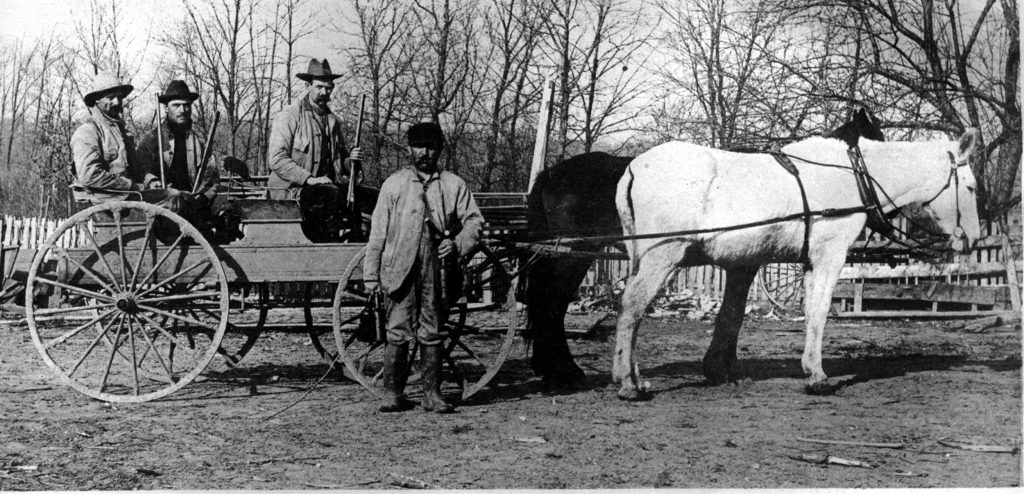“There can be no harm in telling the tale now“ said the grand old man, “It happened when my father was a little boy-it was the case of summary justice in Pleasant Township which brought an end to a long period of timber stealing along the Kankakee. I know young Werich touched gingerly on the incident in his book, so did Reed and Bartlett and Burt Burroughs, in their Kankakee stories, but now for the first time the actual truth is to be told.”
“After the great rock at Momence had been blown up and removed, the Kankakee became in reality, a navigable stream. Before that it had what they called a “drag rock” where in low water trappers and traders and lumber rafters had to drag their stuff over a great flat surface of sloping rock. After that the sawmills at Burkes, and at Howell Landing and Dunns, and Indian Island were able to flatboat lumber to the Des Plaines and on to the Mississippi. There were two steamboats on the river in those days, and the mills had scows load with lumber. I used to stand within the covered bridge at Birches Crossing and watch the lumberman. Lumber was very high in price for a decade or two after the Civil War, and I heard that some of the Kankakee lumber finally ended up at New Orleans-it could have been.”
“Back in the early days just after the war, timber thieves became very bold. They would paddle a homemade rowboat up the river from Momence, spotting good trees that were growing close to the water-and at some further time they’d slip in and cut those trees, trim them, saw them off into 16 foot lengths, and herd them down the river to a saw mill near Momence.”
“I suppose I am the only living person who ever heard of the end of those timber thieves-but that very long ago. They have been buried very deeply in piled up muck dumped by the ditching machines, for so long a time that even I am uncertain of their location.”
“If you remember Rev. Ball’s history you know that three men from Illinois, just across the Lake County line, came up the river and stole choice trees and floated them to the mill. They kept their activities to about $45 a day-$15 for each man. They never repeated in the same vicinity. Gales, Sanders, River Ridge and Lineville were some of the early losers. Then came Water Valley, and Gidleys, and Cornell, and Massy-and goodness only knows how many others. The absentee owners suffered most. I remember I told something of the story to Miss Dittmer for the Anniversary Number of the Vidette-Messenger in 1936-the only mistake in her story was that the timber thieves came at night. That was wrong. They worked in broad daylight-and always had a scribbled map of some kind that indicated the some owner had given them permission. Always it was a mistake when they were caught. The “map” wasn’t accurate enough. That trio worked both sides of the river from Momence to English Lake for a period of over two years.”
“One day one of our neighbors on Loan Oak Island discovered a cross-cut saw, some wedges, an axe, and two peavies hidden under some brush beside the river. These neighbors rowed down the river a ways and found where trees have been newly cut. There were plenty of mud marks, so they reported the affair to some river area farmers who are known as the Jasper Rangers. There was no possibility of a mistake. These were the tools of the timber thieves. The Kershew place had lost valuable logs the previous year, and so had Ferdie Roberts, and Dumont and Aldrich. And since river ice one out this year Particular Felton and Wood and Mr. Gard had suffered losses.”
“Hyde’s cemetery was on Lone Tree Island. Three children and old lady were buried there, so the vigilantes dragged the crooks over to the edge of Hyde’s Cemetery and dug a somewhat shallow grave and dumped all three in it and with them was buried that cache of lumbering tools. I seem to remember that there was an old preacher named Bray, more often call “The Old Brey” behind his back, who lived at Mayville and one of the Rangers said to him “When next there is a burial at Hyde’s Cemetery you might say an additional prayer for any others who may be buried there,” but Old Brey moved back to Kentucky and the ditching machines came in piled a great heap of muck all over the old burial site. I don’t know exactly where it was, everything changed so much since they drained the river flats. If I were to make a guess, I’d say it was on the old Ault place.”
“Indeliably in my memory is that incident of summary justice of Pioneer days, and even now I wouldn’t mention the names of the settlers my father said were the executioners. It was that determined group of men who cleaned up crime all along the Kankakee. It had to be something like that, for there were too many questionable judges, and far too many self-styled lawyers in those days who would, and did, do anything for money.”
“Sometimes I wonder what the Momence sawmill men thought when the trio of timber thieves failed to show up again. He must’ve known all about the whole deal and what happened to the men’s families, if they had any.”
“Somehow there is something about my recalling this story that reminds me of a rather time worn saying father often repeated: “Ill-gotten gains go fast.”


 Stroller
Stroller